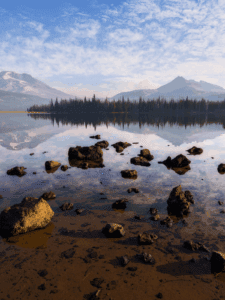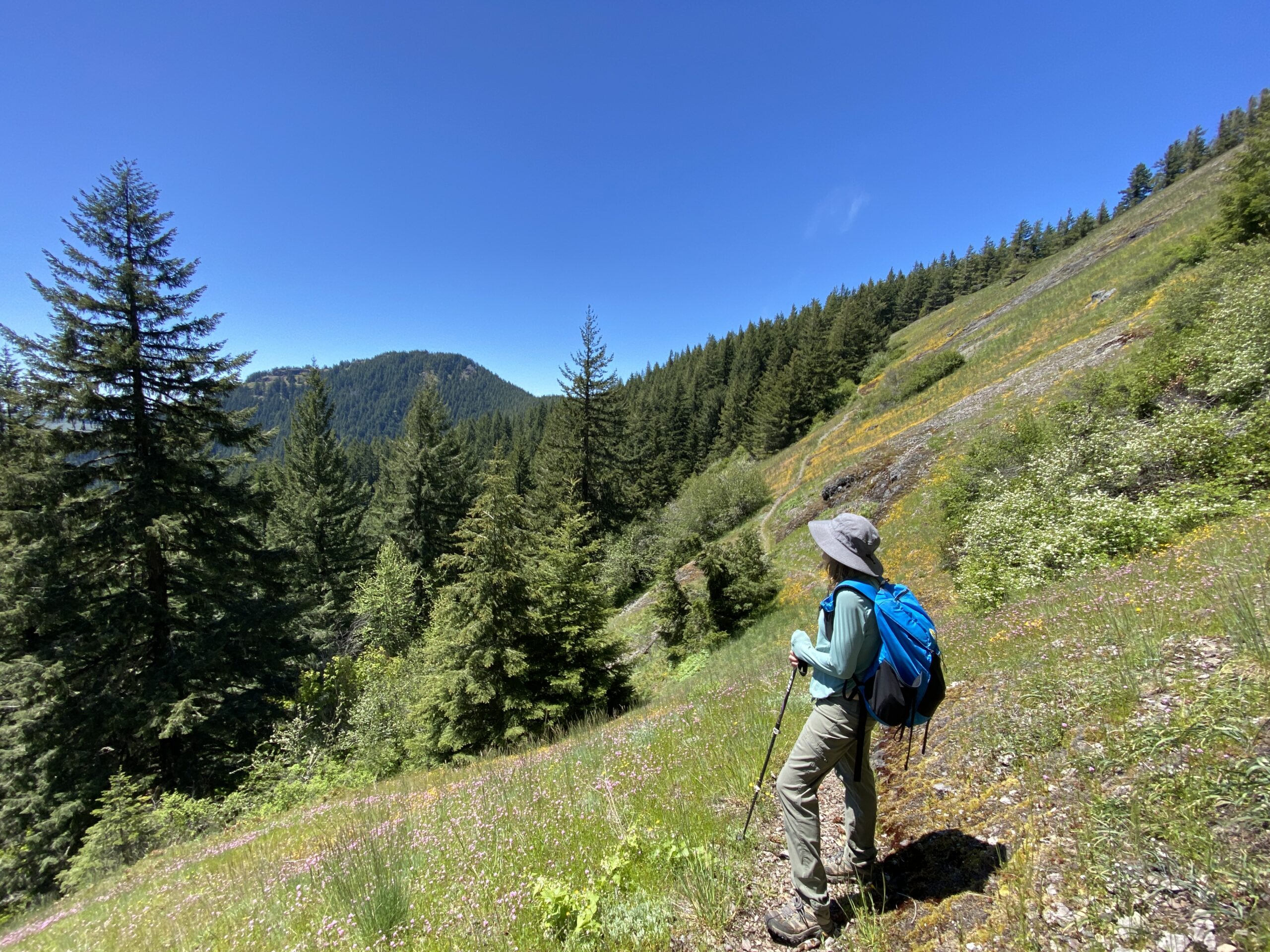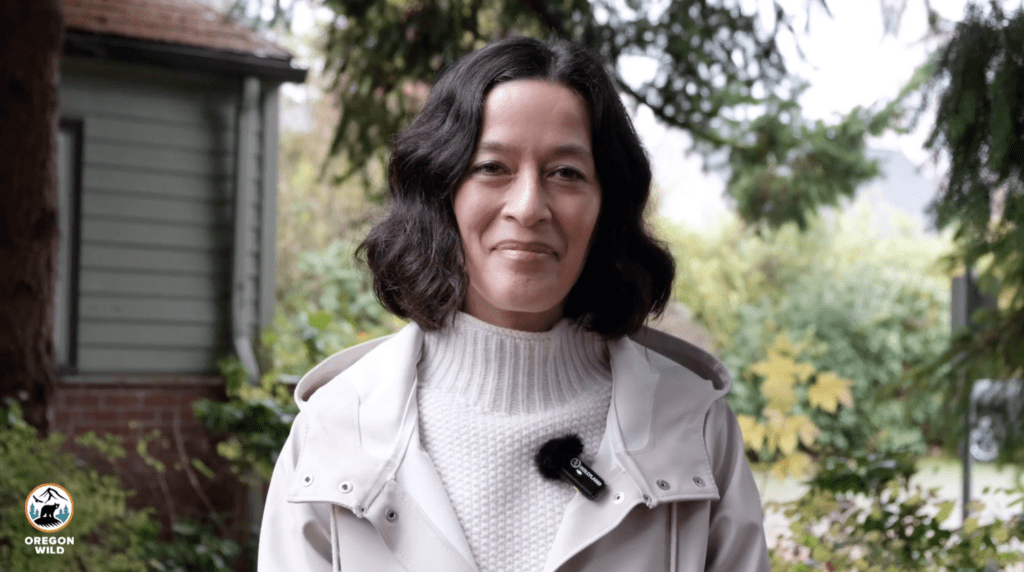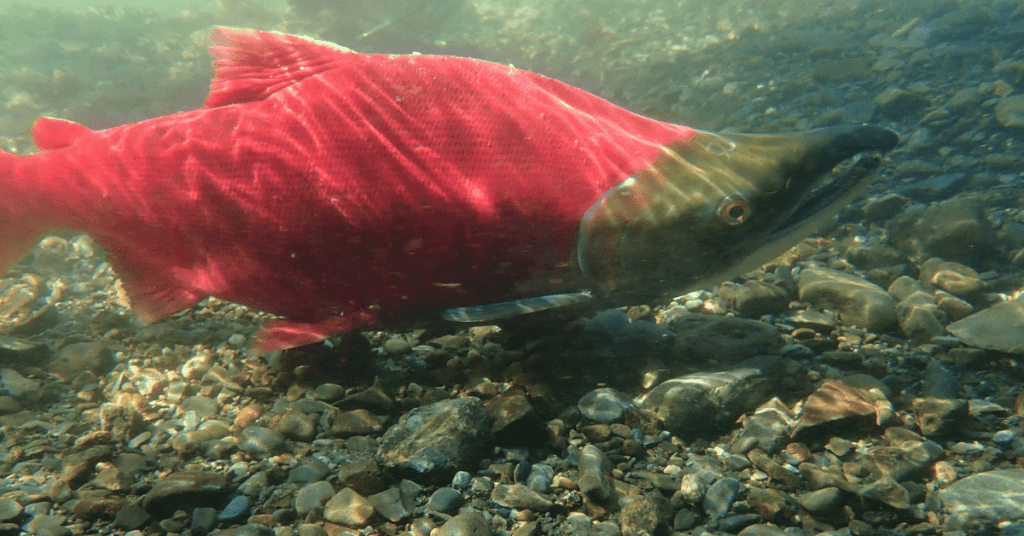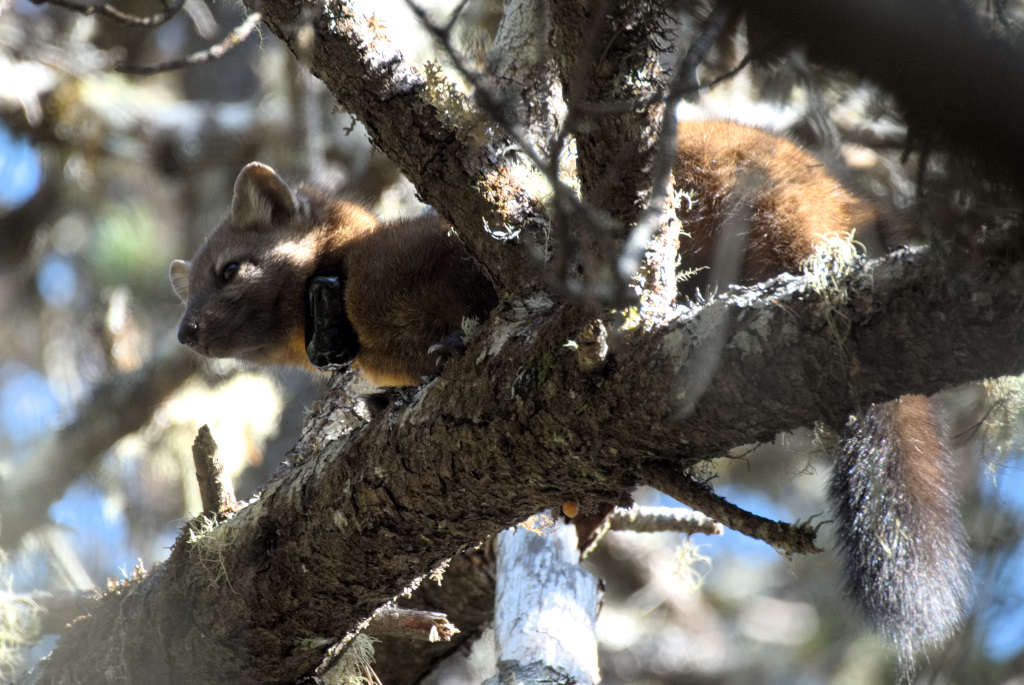By: Marina Richie
Also a part of this series:
Lookout Mountain: Roadless Beacon of the Ochocos
Beloved Metolius River
Every Wild Place Has a Story
Even a lover of ancient forests likes being on top of the world. Lingering on Mount June, I watch turkey vultures tipping wings at eye-level. The month of June is prime time for wildflowers, warblers, and verdant beauty in every shade of green. Oregon Wild’s Chandra LeGue and I bask in the Hardesty Mountain Roadless Area, the largest wild place within an hour of Eugene and Springfield at about 8,000 acres.
This rare gem of lowland Cascade forests is shaped by ancient forces, from wildfire to wind and flood. Many of the conifers are mature forests of 150-year-old hemlocks that grew after a major fire. Throughout are much older Douglas-firs and cedars. Elevations range from 900 feet to Mount June’s summit at 4,618 feet. To the northeast and below us, a sea of downy clouds crest upon Sawtooth Ridge leading to the wooded Hardesty Mountain (4,266 feet). On the far eastern horizon, Mount Bachelor and the Three Sisters shine in icy snow. At my feet, a penstemon blooms a startling magenta among traces of an old fire lookout.
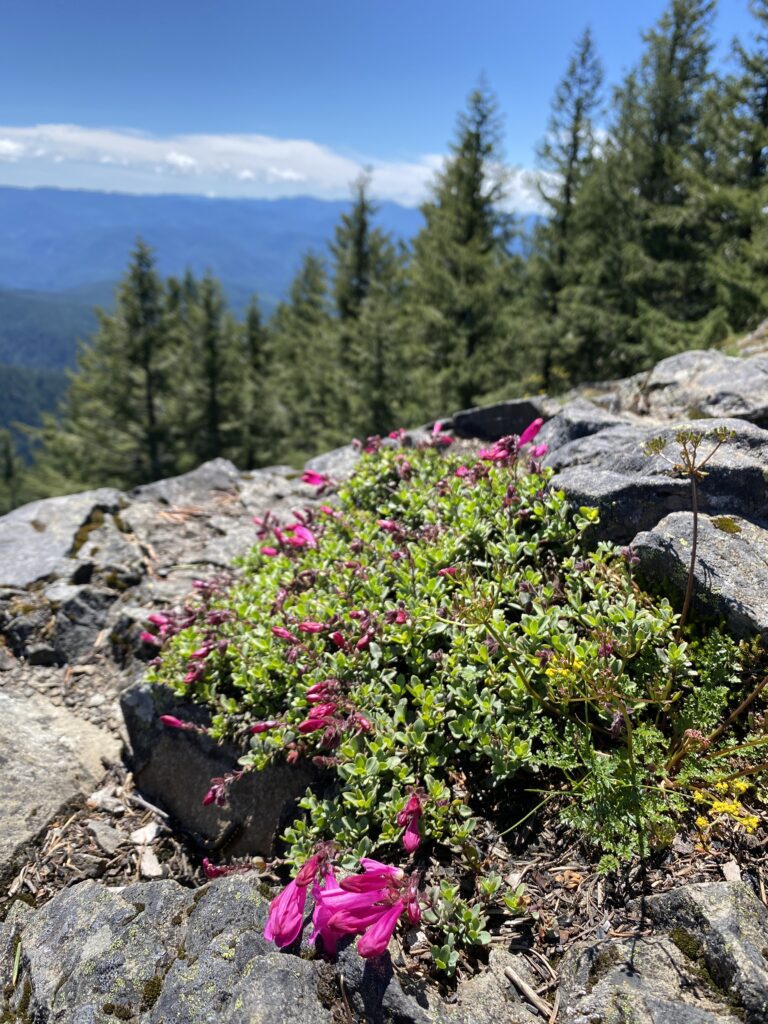
Chandra, senior conservation advocate, has chalked up more than two decades of expertise working for Oregon Wild out of the Eugene office. Reading the landscape of nature and threat with equal acuity, she’s the author of Oregon’s Ancient Forests, a Hiking Guide. Multiple treks in the book lead into roadless areas that lack Wilderness protection. It’s a book that inspires you to roll up your sleeves and do your part to help save every ancient forest remaining in Oregon.
Hardesty Mountain Study Group – Wilderness Campaign
In fact, it was a 63-page booklet called Hiking the Hardesty Mountain Wilderness, published in 1981 by the Eugene-based Hardesty Mountain Study Group (founded by Gail Gredler in 1978) that helped launch a wilderness campaign. As more people explored the 20 miles of the nine trails, they grew intimate with mossy glens, trickling streams, edible mushrooms, and sunlight filtering through tree canopies. Some would become ardent advocates.
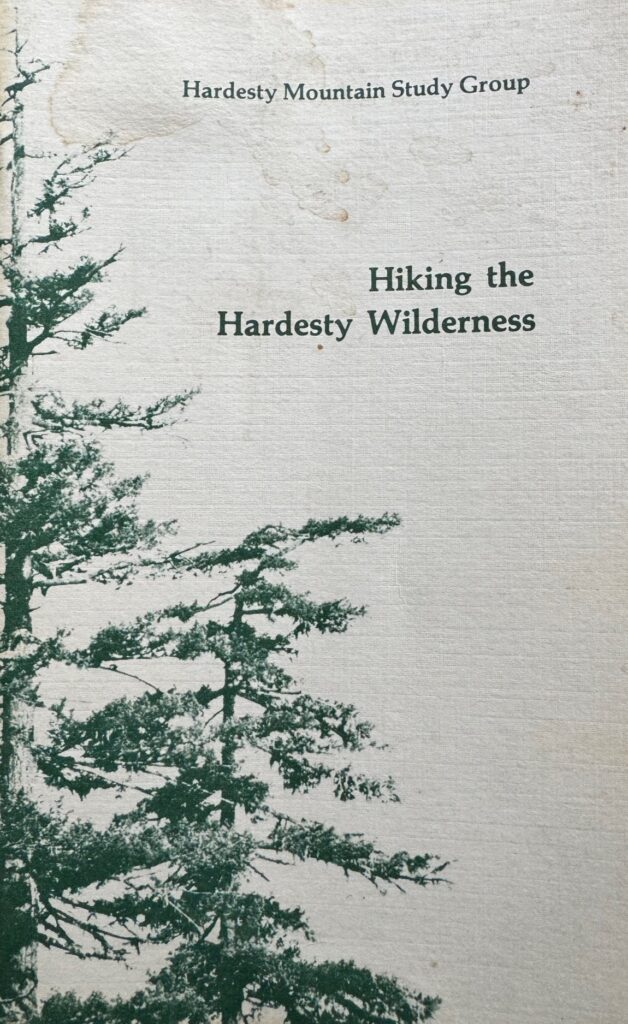
A near final version of the 1984 Oregon Wilderness bill included Hardesty—a triumph to add old-growth forests coveted by the timber industry. In a political maneuver, Senator Mark Hatfield told Representative Jim Weaver to choose which area to retain —Waldo Lake or Hardesty. He picked Waldo as the larger of the two at 39,000 acres.
Since 2001, the roadless rule (protecting Forest Service inventoried areas of at least 5,000 acres) applies to 6,340 acres. However, the citizen inventoried roadless acreage (of 1,000 acres and more) tallies 8,078 acres. That puts some of Hardesty’s wilds at risk.
My connection to Hardesty Mountain dates to 1980 on a rainy University of Oregon field trip for an Oregon Wildlands class. I remember us gathered in a semi-circle around Ken Morton of the Hardesty Mountain Study Group. He stood in front of an immense Douglas-fir that shielded us from the downpour. There, he shared his knowledge, passion, and the dangers the wild forests faced from logging and roads. We returned ready to write personal letters to Congress asking for Wilderness with the big “W.”
Hiking Mount June – Vista Reminders of a Close Call
Chandra and I began our hike from the Mount June trailhead, ascending a mile and a half through a rain-imbued forest swathed in ferns, wood sorrels, trilliums, bleeding hearts, and fawn lilies. Hermit and Townsend’s warblers—birds that thrive in older, multi-storied forests—serenaded us from high among western hemlocks quilling the mist. Pacific wren song bubbled like a hidden spring within leafy vine maples and hemlock saplings.
Leading the way, Chandra alerted me to every banana slug and yellow-spotted millipede on the trail. Like I try to do, she walks with care and exclaims over small miracles, from Calypso orchids to slime molds. At one point, we kneeled by a bone-filled animal scat that seemed too big for a coyote. All wild places are corridors and havens for rare wildlife. We wondered…
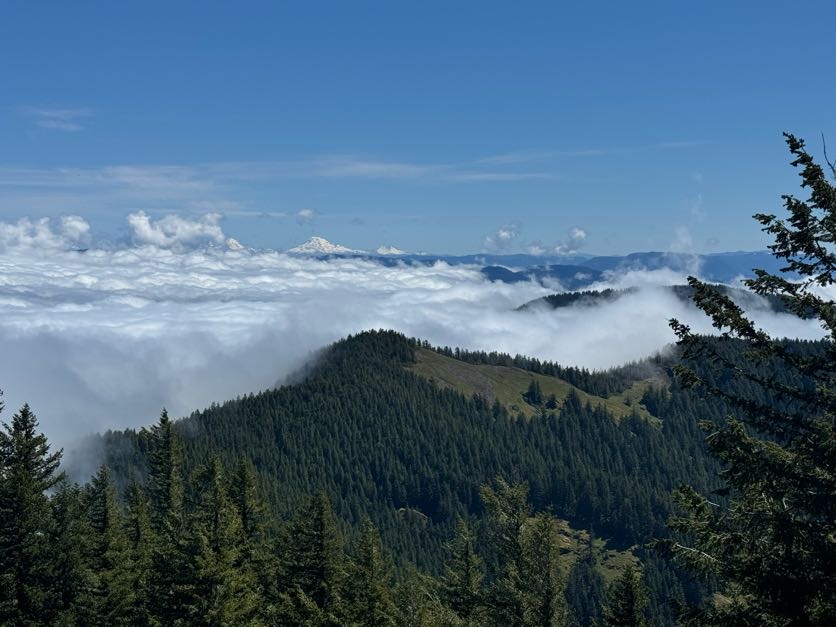
Now above the clouds on Mount June, we breathe in this sanctuary among visible logging scars, including one fresh clearcut gash on distant private land. As we ate our lunch, Chandra pointed southwest to intact forests flowing like a tumbling green river off a ridge into a cradled valley above Cottage Grove. That’s the direction where Hardesty almost lost the integrity of 1,000 roadless acres in 1997. It’s hard to fathom road gashes, huge stumps, and clearcuts like ripped away skin. The years 1995-97 were brutal for Pacific Northwest ancient forests. A timber sale aimed at some of Hardesty’s oldest and biggest trees slipped through the cracks in late December of 1996, only eight days before the expiration of the “salvage rider,” a clearcutting binge targeting old-growth trees on national forests. Exempted from most environmental laws, sales were churning out fast and furious. Oregon Wild’s Conservation and Restoration Coordinator Doug Heiken was then in the thick of the onslaught. When I asked him about the Judie timber sale, he credited Francis Eatherington and urged me to contact her for the story.
Enter Francis Eatherington – Judie Timber Sale of 1997
Sold to the Seneca Jones Sawmill in December 1996, the Judie timber sale barreled onward until Francis took notice. By then it was summer of 1997. New road construction heading into the roadless area had begun and failed, causing landslides, and threatening the purity of Cottage Grove’s drinking water.
Some might have despaired. Francis instead set off an alarm that would ring all the way to the halls of Congress when at the last-minute Representative Peter DeFazio stepped in and finessed a buy back of the timber sale. Today, there’s a harsh reminder of the Judie timber sale. The road building obliterated a mile of the Old Hardesty Way Trail at the lower end.
Francis began her stellar environmental career as a volunteer in 1996 for the newly formed Umpqua Watersheds. Soon, she was conservation director and in 2010 took on the same position for Cascadia Wildlands. In 2015, she shifted to parttime advisor focusing on the Elliott State Forest. Francis lives west of Roseburg on a land collective, her home for the last 50 years. She’s still defending the Umpqua’s forests, and reaching out to children with environmental education, too.
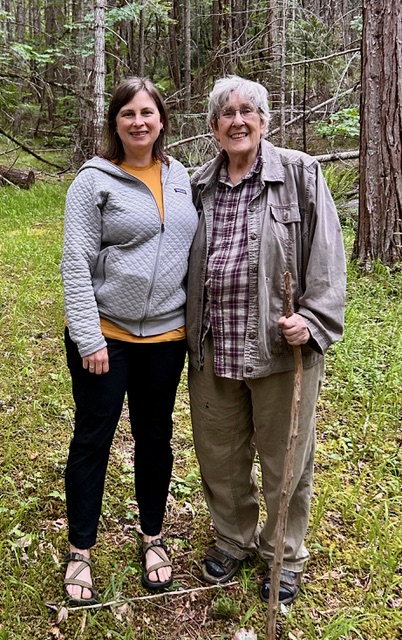
When we spoke on the phone, Francis was prepared with 207 emails related to Hardesty right at her fingertips. Archival record keeping is second nature to her and invaluable to the environmental movement. We learn from past tactics and take heart from courageous actions. While modest on our call, I am still learning of her awesomeness. Here’s what Cascadia Wildlands director Josh McLaughlin wrote in 2015, a tribute called “Marching in Francis’ Army”:
“I remember first meeting Francis Eatherington the day she rolled into an Earth First! road blockade high up on the Umpqua National Forest on her motorcycle. She was wearing a leather biking jacket, had a stack of timber sale maps under her arm, a compass dangling from her neck and a ruffled brow, shaking her finger in the air, furious that the Forest Service was intent on punching roads and logging units into the adjacent Mt. Bailey roadless area.”
Defending Hardesty Mountain roadless area was one tiny piece in her decades-long advocacy for the forests of the entire Umpqua Basin, from Crater Lake headwaters all the way from the Cascades to the Coast Range and the Oregon Dunes.
“When the salvage logging rider was putting forward old timber sales, I knew how to find them,” she told me. “It was pretty bad, They wanted to liquidate the old growth.”
She scrambled over mossy fallen trees through cathedral groves on the chopping block and far from public scrutiny—bringing them to light and helping to fuel public outrage over the desecration of national forests.
Francis was the ideal person to find and document spectacular groves people would never know otherwise. After working for the Hoedads (the legendary tree-planting collective that championed women in the forestry field) from 1979 to ’81, she started Three Sisters Forestry—climbing trees to pick cones and trekking through trail-less forests with map and compass in hand conducting timber stand exams.
She soon realized her mapping, forestry, and field skills were needed for Umpqua Watersheds to succeed in saving threatened forests. But she had to learn how to write appeals and apply the National Environmental Policy Act (NEPA). She made sure the Umpqua National Forest sent her notice of every planned timber sale.
How then could she have missed the Judie timber sale? In fact, the staff told her they forgot to send her the Environmental Assessment (EA). When she finally got her hands on the EA, there was not even a map. Clearly, the sale violated the salvage rider’s stipulation to avoid timber sales in inventoried roadless areas. Delving in more, she found the agency had arbitrarily moved the roadless area boundary on the Umpqua National Forest a few years earlier, cutting out half of the 2,500 acres on the forest. (The remaining roadless acres are on the Willamette National Forest with a small piece overseen by the Bureau of Land Management).
To top it off, the sale was smack dab in the Layng Creek municipal watershed for the city of Cottage Grove, where strict regulations prohibited people from swimming or overnight camping. Notice to the city was bypassed as well.

By August of 1997, Francis was sending out alerts to environmentalists and contacting reporters. In one activist email she described the 400-acre Judie timber sale as “punching 2.2 miles of new roads into the Hardesty Mountain roadless area…What the new roads can’t get to, helicopter logging will clearcut from deeper within the roadless area.”
She pointed out that the Forest Service was trading public old-growth for new logging roads by offering the timber company $254,000 in purchaser credits. When the road collapsed and sediment entered Layng Creek upstream from the intake valve for the city’s water, the timber company got an additional $495,300 to fix it. Geologists had warned of the unstable soils, but they were ignored.
The travesties kept coming. The Umpqua National Forest sold 23 percent more timber than they’d analyzed, offering 7.4 million board feet or 1,490 log trucks slated to be “rolling over the new roads, hauling away centuries-old forests from the municipal watershed,” as Francis wrote.
Those logs would have originated in the upper reaches of Herman Creek, harboring the oldest and biggest trees in the Layng Creek watershed –ranging in ages from 600 to 400, 250, and 100-years old. Multiple ages are signs of what make a wildfire-evolved ancient forest complex and dynamic. A that time, at least 18 pairs of northern spotted owls lived among the multi-layered forests featuring plentiful snags.
With time running out, the alarm Francis raised now rang through all the area’s environmental groups. By the fall of 1997, Representative DeFazio promised to do his best to save the roadless area. In December, he prevailed.
One lesson of the Judie timber sale is that it’s never too late to act and “make a ruckus” as Braiding Sweetgrass author Robin Wall Kimmerer recently advocated at an event in Bend I attended. The other? I’d say map and field skills. The work today of youthful activists ground-truthing timber sales is exciting in the resulting victories for our still threatened older forests. Before our call ended, I asked Francis how she might describe herself as a forest activist.
“I would tell people I was a typist and a professional complainer,” she said. “I enjoyed complaining about these timber sales. I was driven. That might be a better word for me.”
Francis joins a long line of advocates for Hardesty, like the Sierra Club Many Rivers Group that led a wilderness campaign from 2010 to 2015.
John’s Last Stand Timber Sale – Close Call of 2015-16
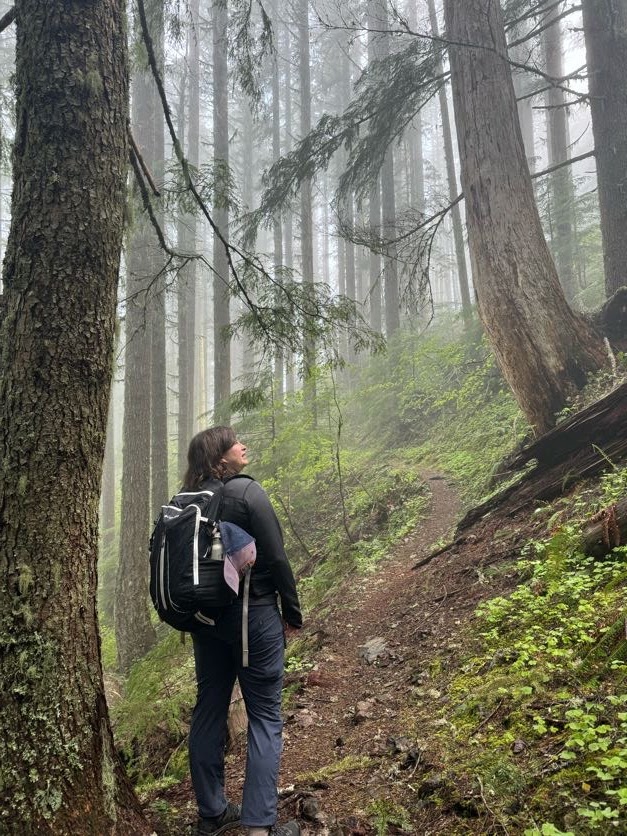
On our way back, Chandra and I add an extra three miles out Sawtooth Ridge toward Hardesty Mountain. Along that ridge with the map of John’s Last Stand timber sale in hand, Chandra identifies the steep slope right below us that came perilously close to being clearcut in 2016. The trail follows the divide between the Umpqua National Forest to the south and Bureau of Land Management to the north. The 2001 roadless rule does not apply to the BLM, which puts this piece of Hardesty at high risk. Chandra and other forest activists led field trips from the lower end of the sale. Environmental groups sprang into action.
After Oregon Wild, Cascadia Wildlands, the Sierra Club, and others commented, filed protests, and appealed—denied at every step—the BLM finally dropped the timber sale. It’s a reminder that roadless areas cross boundaries and public pressure is powerful. As we paused there, a hermit warbler gave his spirited uplifting song from the forest saved from logging
Soothed in the thrum of centuries-old trees on our descent to the trailhead, I listen to Pacific wrens, warbling vireos, western flycatchers, and hermit warblers that know no boundaries. Here, wildfires have burned at different intensities and in mosaics. High winds may topple certain trees and create open sunny gaps. Everywhere are the signs of cyclical life and death. The death of an old cedar, fir, or hemlock only marks another phase of life—as a giver of food and shelter for woodpeckers, owls, chickadees, nuthatches, squirrels, and even bears denning in the hollow bases of great trunks. Fallen trees ease into their new roles as mossy nurse logs for saplings and havens for salamanders.
Come to Hardesty Mountain Roadless Area. Open your senses to complexity, intricacy, and a resilient ever-changing forest shaped over thousands of years. Whether hiking or mountain biking, take time for the small wonders. Watch your step. Help protect every roadless area of every size. Speak up for Wilderness. And stand up for all mature and ancient forests at this pivotal time in history.
Current efforts to increase protections for mature and old-growth forests for National Forests are vital for forests like those in this roadless area. Take action here!
Visit
- Oregon Wild’s Chandra LeGue will lead a Mount June Hike on Saturday, June 22. Register here.
- Goodman Creek Trail is featured in Oregon’s Ancient Forests, A Hiking Guide, for easy access to big trees year-round and right off Highway 58, on the edge of the Hardesty Mountain Roadless Area
